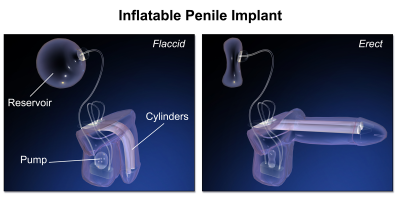Penile implants used for the treatment of erectile dysfunction (ED) are an extremely viable and effective treatment option for many men who suffer from the condition. Penile implants have been used for over eighty years now and have transformed into one of the most common and satisfactory treatments for ED in a majority of patients. With recent innovations in the implant procedures, plus the ongoing revolutionary new designs and materials being utilized, some satisfied patients have found penile implants to be the best answer and treatment option for them.
What Are Penile Implants?
Penile implants are a procedure where a physician surgically places a medical device known as a penile prosthesis (or penile implant) inside of a man's penis. Although other less invasive treatments are available (such as oral prescription medications and/or vacuum erection devices), penile implants are a very viable treatment option for men in which these other treatment options may prove to be unsuccessful or are contraindicated. There are basically two types of penile implant devices commonly used: non-inflatable (semi-rigid) devices and inflatable penile prosthesis devices (often referred to as an IPP).
History
The very first documented penile prosthesis dates all the way back to the sixteenth century when Ambroise Paré created and inserted an artificial penis that was made out of wood into a patient. Although it was not very successful, the purpose was not to treat ED, but to help the patient urinate after suffering a traumatic penile amputation.
The first documented penile implant intended to treat erectile dysfunction was designed and inserted into a patient by a Russian surgeon named Nikolaj Bogoraz all the way back in 1936. Considered to be the "father of penile implants", Bogoraz was a pioneer not only in implants, but also in phalloplasty (the surgical reconstruction of a man's penis and surgical modification attempting to enlarge a man's penis). His initial attempt was an implant constructed out of bone and cartilage from the patient. Considered initially successful, the implant was reabsorbed by the patient's body several years after the procedure.
Next was the use of acrylic rods to counteract the reabsorption problem. In 1952 Dr. William Scott and Dr. Willard Goodwin surgically inserted the acrylic rods into patients with some success. However, both the erosion of the acrylic material and the extremely high infection rates encountered soon led to the use of a prosthetic rod comprised out of rubber and silicon in 1964. The rod was placed outside of the corpora cavernosum, but this also resulted in both erosion and extrusion problems over time. Finally, in 1967, Dr. Bob Pearman solved the issues by placing a solitary rod of silicone beneath the patient's tunica albuginea located inside of the corpora cavernosum.
Finally in 1980 the first malleable (or semi-rigid) implant was designed. Made of two silicone rods, the device additionally was embedded with an inner core that was comprised of silver wire. Now the patient had the option of either bending his penis when urinating or wanting to conceal it, plus straightening it when wanting an erection for sexual activity. Semi-rigid devices used today model this design (and have cores composed of either a spiral silver wire or of braided stainless steel).
The Inflatable Penile Prosthesis (IPP)
The semi-rigid or malleable implant still didn't have the concealment level that many ED patients wanted. Many men desired an more natural look while in the lax, limp or flaccid condition. To meet this need a Dr. F. B. Scott, a urologist at Baylor University, became the "Father of the IPP". Dr. Scott developed the first inflatable penile prosthesis, comprised of three pieces: two inflatable cylinders that connect to a scrotal pump and an intra-abdominal fluid storage unit. The device worked by the patient manually compressing the pump, which forces the fluid from the storage unit into to the penile cylinders. When the cylinders fill up, an erection results allowing the patient to perform sexually and have normal intercourse. Additionally, a valve was placed in the pump that allowed deflation, thus emptying the cylinders and returning the fluid to the storage unit. The IPP allowed the ED patient to initiate and maintain an erection when it was desired, plus then deflate back to a normal look otherwise.
Since the development of the initial device, IPP's have been constantly improved through the innovative use of different designs and materials. There is even now a two piece device that was developed, but the expandability and hardness of the erection are more limited than seen with the three piece device.
Questions About Penile Implants in Treating ED?
At Philadelphia Urology Associates, Dr. Bruce Sloane is a nationally renowned specialist in Men's Health issues and Age Management Medicine. Throughout Philadelphia and the surrounding areas, patients seek his expertise to treat erectile dysfunction and other sexual performance issues. Using state-of-the-art equipment and having extensive specialized education and training, Dr. Sloane will find the treatments and solutions that will work best for you.
If you have any questions about the treatments available for Erectile Dysfunction (ED) or other urological disorders, we urge you to contact us now online or call us at (215) 563-1199 today to discuss how we can help you!
